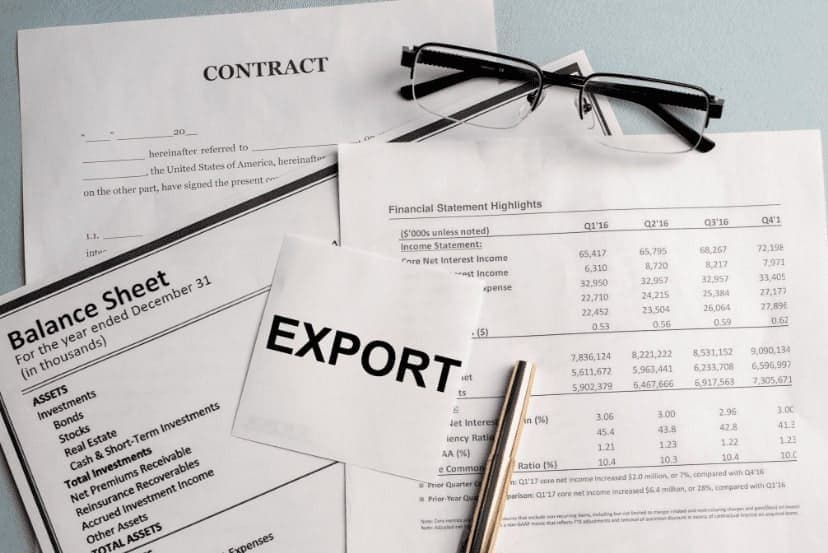Did you know that in the dynamic world of international trade, there are diverse types of Export Letters of Credit, each with its own set of clauses and payment terms? Let’s explore this fascinating realm where businesses secure their transactions, ensuring smooth and reliable global commerce.
From the commonly used Irrevocable Letters of Credit that provide steadfast security to the flexibility of Transferable Letters of Credit allowing credit transfer between parties, these instruments play a crucial role in shaping the landscape of cross-border transactions.
Discover how Red Clause Letters of Credit facilitate pre-shipment advances, or how Standby Letters of Credit act as dependable backups in case of defaults. With straightforward language, we’ll unravel the intricacies of these financial tools, shedding light on their roles, benefits, and the variety they bring to the world of international business. Join us on this journey to demystify Export Letters of Credit and empower your understanding of global trade dynamics.
What is Export Letters of Credit?
Export Letters of Credit are financial instruments commonly used in international trade to facilitate secure and reliable transactions between a buyer and a seller, especially when they are in different countries. In simple terms, an Export Letter of Credit is a commitment issued by a bank on behalf of the buyer (importer) to pay the seller (exporter) a specified amount under certain conditions.
How Does it Work?
The working of an Export Letter of Credit involves a series of steps to ensure a secure and smooth international trade transaction. Here’s a step-by-step breakdown of how it typically works:
Agreement
The buyer and seller agree to use a Letter of Credit as the payment method for their international trade transaction. This agreement is often part of the sales contract.
Issuance
The buyer (importer) applies for an Export Letter of Credit from their bank (issuing bank). The issuing bank issues the Letter of Credit, providing a financial commitment to pay the seller (exporter) a specified amount, subject to the fulfillment of certain conditions.
Terms and Conditions
The Letter of Credit includes specific terms and conditions that the seller must meet to receive payment. These conditions typically involve the presentation of compliant documents, such as the invoice, bill of lading, and other shipping documents.
Notification to Seller
Once the Letter of Credit is issued, the issuing bank notifies the seller and provides them with the details of the credit, including the conditions that must be met.
Shipment and Document Preparation
The seller ships the goods to the buyer and prepares the required documents in accordance with the terms specified in the Letter of Credit.
Document Presentation
The seller presents the documents (invoice, bill of lading, inspection certificates, etc.) to their bank, known as the advising or negotiating bank.
Document Examination
The advising or negotiating bank examines the documents to ensure they comply with the conditions stipulated in the Letter of Credit.
Forwarding to Issuing Bank
If the documents are in order, the advising or negotiating bank forwards them to the issuing bank.
Payment
The issuing bank examines the documents once again to verify compliance. If everything is in order, the issuing bank makes the payment to the seller as per the terms of the Letter of Credit.
Transfer of Ownership
Upon payment, the issuing bank obtains the documents and releases them to the buyer. The buyer can then claim the shipped goods from the carrier.
The Export Letter of Credit acts as a secure mechanism, ensuring that the seller is paid only when they fulfill the agreed-upon conditions. It provides confidence to both the buyer and the seller, facilitating international trade by minimizing the risks associated with cross-border transactions.
Types of Export Letters of Credit
What are the Different Types of Export Letters of Credits
Here are 16 types of Export Letters of Credit, each serving specific purposes in international trade:
Irrevocable Letter of Credit
An Irrevocable Letter of Credit is a steadfast commitment from the issuing bank, providing a secure financial arrangement that cannot be altered or revoked without unanimous agreement from all parties involved in the transaction.
Once issued, this commitment assures the seller that the terms and conditions specified in the letter remain unchanged, offering a high level of certainty in international trade. This type of letter of credit enhances the confidence of both the buyer and the seller by ensuring the stability of the financial arrangement throughout the course of the transaction.
Confirmed Letter of Credit
A Confirmed Letter of Credit includes extra assurance in international transactions. Here, a confirming bank, in addition to the primary bank, adds its approval to the credit issued. This confirmation acts like a double guarantee, ensuring the seller that payment will be made. It’s like having a backup buddy – if the primary bank faces issues, the confirming bank steps in, offering an extra layer of security.
This setup boosts trust between the buyer and seller, making cross-border deals smoother and more reliable. In simple terms, it’s like having a friend vouch for you to make sure everything goes as planned.
Unconfirmed Letter of Credit
An Unconfirmed Letter of Credit relies entirely on the trustworthiness of the issuing bank, skipping the involvement of a second bank’s confirmation. It’s like a one-person show, where the issuing bank’s credibility becomes the sole basis for the seller’s confidence. In this scenario, there’s no backup confirmation from another bank; it’s all about trusting the first bank’s ability to fulfill the payment commitment.
While it simplifies the process by having only one player involved, it also means there’s no extra layer of security. It’s a direct deal, placing reliance on the initial bank’s financial strength.
Transferable Letter of Credit
A Transferable Letter of Credit gives exporters the flexibility to pass on the credit to someone else, like a middleman or secondary beneficiary. It’s like handing over a part or the whole payment assurance to another trusted player in the game. This ability to transfer the credit adds a layer of adaptability in trade dealings.
It’s akin to saying, “Hey, I got this Letter of Credit, but I want you to handle it now.” This way, various parties can be involved in the transaction, making the process more versatile and accommodating to different business arrangements.
Back-to-Back Letter of Credit
A Back-to-Back Letter of Credit introduces a two-step process in international trade. Here, there are two separate credits issued: one for an intermediary (like a middleman) and another for the final seller. It’s like having a relay race for payments – the first credit goes to the middleman, who then passes the payment baton to the ultimate seller.
This setup facilitates complex trade arrangements by involving an intermediary in the financial process. It’s a bit like breaking down a big financial deal into two manageable steps, allowing for smoother transactions and involving multiple parties in the trade game.
Red Clause Letter of Credit
A Red Clause Letter of Credit comes with a special clause offering a head start to the exporter. This clause allows the bank to make a prepayment to the exporter even before the goods are shipped. It’s like getting a financial boost upfront, especially handy for covering initial expenses tied to the trade.
Imagine it as an early payment card, ensuring the exporter has the necessary funds to kickstart the transaction. This type of letter of credit brings flexibility, aiding in managing upfront costs and ensuring a smoother start to the international trade process.
Green Clause Letter of Credit
A Green Clause Letter of Credit is like a cousin to the Red Clause version but with an added feature. Just like Red Clause, it permits a prepayment to the exporter before shipping, acting as a financial head start. However, the ‘Green’ version goes a step further by including provisions for inspecting the goods before shipment. It’s like having an extra checkpoint in the trade journey, ensuring everything is in order before the goods set sail.
Commonly used in commodity trades, this type of letter of credit blends financial flexibility with quality assurance, making it a handy tool in certain international transactions.
Sight Letter of Credit
In a Sight Letter of Credit, it’s a “see now, pay now” scenario. Once the exporter shows all the required documents, the payment is made right away. It’s like an instant transaction where the buyer doesn’t wait around – as soon as everything checks out, the money is sent. This quick and straightforward process ensures a rapid exchange in international trade.
Imagine it as a smooth, on-the-spot payment method, providing efficiency and immediate compensation for the exporter’s efforts once all the necessary paperwork is in order.
Time or Usance Letter of Credit
A Time or Usance Letter of Credit is like a financial time-travel ticket for buyers. Instead of paying immediately, it allows them to defer payment to a future date mentioned in the credit. It’s a bit like saying, “I’ll pay you later.” This setup gives the buyer time to generate revenue from the goods they’ve purchased before making the payment.
Think of it as a way to synchronize payment with the buyer’s cash flow, providing a more flexible arrangement in international trade where time becomes a crucial factor in financial transactions.
Standby Letter of Credit (SBLC)
A Standby Letter of Credit (SBLC) acts like a financial safety net in international trade. It steps in as a backup payment plan if the buyer fails to meet their agreement, ensuring that the seller still gets paid. It’s a bit like having a trustworthy friend who covers your expenses if needed.
This standby role makes the SBLC a reliable guarantee – not meant to be used unless things go south, but providing assurance that financial support is ready if the original payment plan falls through. It adds an extra layer of security and confidence in cross-border transactions.
Revolving Letter of Credit
A Revolving Letter of Credit is like a never-ending credit loop, beneficial for continuous trade partnerships. Here’s how it works: After every use (drawing), the credit amount automatically bounces back, ready for the next transaction. It’s like a reusable shopping card – once you spend, it refreshes for the next purchase.
This setup is handy for businesses engaged in ongoing trade, ensuring a seamless and efficient flow of financial resources. The “revolving” nature means the credit is a perpetual resource, ideal for sustained trade relationships where parties engage in multiple transactions without the need for constant reapplication.
Deferred Payment Letter of Credit
A Deferred Payment Letter of Credit is like a financial crystal ball, allowing payment to happen in the future. Instead of an immediate transaction, it gives the buyer the flexibility to pay at a specified later date. It’s akin to saying, “Let’s settle the bill down the road.” This setup offers a convenient timing arrangement, allowing the buyer to manage their cash flow before making the payment.
Think of it as a way to synchronize payment with the buyer’s financial plans, providing a handy tool for international trade where timing can play a crucial role in financial transactions.
Anticipatory Letter of Credit
An Anticipatory Letter of Credit is like a financial foresight tool in international trade. It’s opened in advance, foreseeing future trade transactions. It’s a bit like saying, “I trust we’ll do more business together.” This proactive approach provides assurance for ongoing trade relationships. It’s not about an immediate need but about being prepared for what lies ahead.
Think of it as a way to signal commitment and trust in a business partnership, laying the groundwork for smoother and more confident transactions down the line. It’s like having a financial handshake that says, “Let’s keep this trade relationship going.”
Direct Pay Letter of Credit
A Direct Pay Letter of Credit streamlines the payment process in international trade. Here’s how: The issuing bank directly pays the seller once all required documents are in order. It’s like having a direct line from the bank to the seller – no middlemen involved. This setup simplifies the payment journey, making it efficient and straightforward.
Think of it as a shortcut to payment fulfillment; the moment the seller provides the necessary paperwork, the bank swiftly releases the payment. This direct approach enhances the speed and ease of transactions, ensuring a smooth financial exchange in cross-border business dealings.
Traveler’s Letter of Credit
A Traveler’s Letter of Credit is like a financial companion for globetrotters. It helps cover expenses for individuals traveling abroad, commonly used for personal travel costs. It’s like having a money guide that ensures you’re covered while exploring different corners of the world.
This letter of credit simplifies the financial aspect of travel – you don’t need to carry large sums of cash; instead, you have a secure document ensuring you can access funds as needed. It’s a reliable and convenient way to manage expenses during your adventures, providing peace of mind and financial flexibility on the go.
Insurance Letter of Credit
An Insurance Letter of Credit is like a safety shield for exporters in international trade. It’s there to provide financial protection in case of certain events, such as non-payment or default by the buyer. Think of it as an insurance policy for your payment – if something unexpected happens, you’re covered.
This type of letter of credit acts as a security blanket, ensuring that even if the buyer faces financial difficulties, the exporter is safeguarded. It adds an extra layer of assurance, making transactions more secure and allowing exporters to engage in trade with increased confidence.
Understanding these types of Export Letters of Credit allows businesses to choose the most suitable instrument for their specific trade requirements and risk considerations.
Final Words
In the dynamic realm of global trade, Export Letters of Credit play a pivotal role, offering diverse options to secure transactions. From the unwavering security of Irrevocable Letters to the adaptability of Transferable Credits, each type serves a unique purpose. Whether it’s immediate payments with Sight Letters or deferred transactions with Usance Credits, these instruments provide flexibility.
Standby Letters act as safety nets, while Revolving Credits ensure a perpetual financial flow. Each type caters to specific needs, facilitating trust and efficiency in cross-border dealings. As businesses navigate international trade complexities, choosing the right letter empowers them for secure and seamless transactions.




